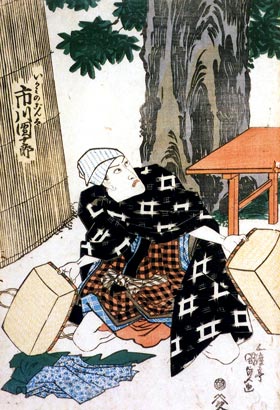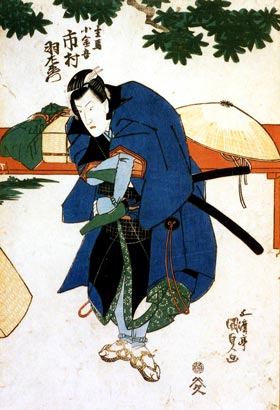| KO-NO-MI |
| Play title | Yoshitsune Senbon Zakura Yoshitsune and the Thousand Cherry Trees |
| Authors | Takeda Izumo II Miyoshi Sh˘raku Namiki Senryű I |
| History |
The play "Yoshitsune Senbon Zakura" was originally written for the puppet theater (Bunraku) and staged for the first time in the 11th lunar month of 1747 in ďsaka at the Takemotoza. It was adapted for Kabuki the following year and staged for the first time in the 1st lunar month of 1748 in Ise with Kataoka Nizaemon IV (Tokaiya Ginpei, Yokawa no Zenji Kakuhan) and Yamamoto Koheiji (Tadanobu). It was performed for the first time in a city licensed theater in the 5th lunar month of 1748, in Edo at the Nakamuraza [casting]. The "Ko-no-Mi" and "Kokingo Uchijini" scenes were performed with Sawamura Ch˘jűr˘ III, Ichikawa Yaoz˘ I, Arashi Tamagashiwa, Sawamura Utagiku and Nakamura Nakaz˘ I in the roles of Gonta, Kokingo, Wakaba-no-Naishi, Gonta's wife Kosen and Gonta's son Zenta. The first performance in ďsaka was done in the 8th lunar month of 1748, at the Naka no Shibai [casting], and the "Ko-no-Mi" and "Kokingo Uchijini" scenes were performed by Nakamura Utaemon I (Gonta), Ichimura Sanohachi (Wakaba-no-Naishi, Kosen) and Yamatoya Jinbŕ IV (Kokingo). |
| Structure | The "Ko-no-Mi" and "Kokingo Uchijini" scenes, which are nowadays regularly performed, are the first and second scenes of act III. |
| Key words | Genpei-kassenmono Genji Gidayű Ky˘gen Giri/Ninj˘ Heike Jidaimono Minamoto Yoritomo |
| Summary |
Previous scene: "Daimotsu no Ura" Shimo-Ichimura Shii no Ki Wakaba, the wife of Koremori, a young fugitive Heike lord, and her son are travelling in search of him with their servant Kokingo. While they are resting at a roadside tea stall, Gonta enters and tries to strike up a conversation. Shortly he leaves, purposely walking off with Kokingo's pack and leaving his own identical one in its place as if by mistake. Before long Kokingo notices the switch and is about to go off in pursuit, when Gonta comes rushing back effusive in his apologies at his mistake. He swears he hasn't touched a thing and asks Kokingo to confirm that everything is intact. A relieved Kokingo does so, but Gonta now notices that his own pack has been opened. He frantically searches but claims that the 20 ry˘ which he had hidden between layers of clothing are missing, and in an increasingly loud and menacing voice he accuses Kokingo of being a stinking thief and demands his money back. Kokingo is outraged at this slur on his character but is restrained from drawing his sword by Wakaba, and close to tears throws 20 ry˘ of his own money at Gonta, and leaves. A smug Gonta is just congratulating himself on a having done a nice bit of work when his wife, Kosen the tea stall owner, and son emerge to confront him. She upbraids him for his crooked ways and points out that he's known as "Gonta the Swindler" by everyone in the area, and that their son is bullied because of Gonta's bad reputation. It seems to be like water off a duck's back to Gonta, but finally we see him warm his son's cold hands and carry him home on his back. This an important moment in the play, for without it we would never fully realize the tragedy of Gonta's fate in the next act. Text courtesy of Jean Wilson (July 1998) Next scene: "Kokingo Uchijini" |
 |
 |
|
The actors Ichikawa Danjűr˘ VII and Ichimura Uzaemon XII playing the roles of Gonta and Kokingo in the "Ko-no-Mi" scene of the drama "Yoshitsune Senbon Zakura", which was staged in the 7th lunar month of 1828 at the Ichimuraza (print made by Utagawa Kunisada I) |
|
|
|
| Contact | Main | Top | Updates | Actors | Plays | Playwrights | Programs | Links | FAQ | Glossary | Chronology | Illustrations | Prints | Characters | Derivatives | Theaters | Coming soon | News |